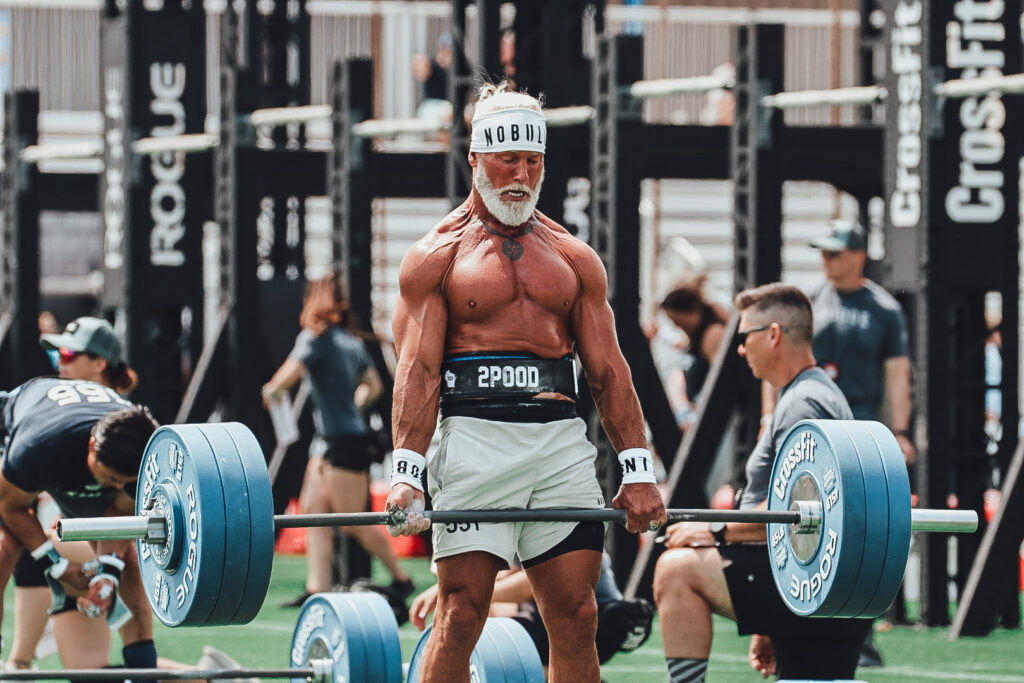
Where Do You Stack Up Against These Masters Strength Numbers?
Researched and written by Nichole Kribs with contributions from Hunter Britt, Jared Enderton, and Michele Vieux
Many of you have seen the article ‘Strength is the Price of Admission.’ That article gives suggestions for strength numbers for athletes looking to be competitive in CrossFit. Recently we realized that we don’t have an article that highlights masters strength numbers for athletes looking to be competitive. This led us to dig deep into research and create some general strength guidelines for Masters athletes looking to be competitive.
General Guidelines for Competitive Masters’ Strength Numbers
Now, let’s be clear about a few things. This is a general guideline for competitive strength numbers. This doesn’t mean your 1RM’s need to match these numbers or else you won’t be competitive but our hope is to give athletes an idea of the overall strength top competitive athletes have.
We definitely don’t have as much data as elite individual athletes simply because Masters haven’t been competing as long as individuals, but we have been able to pull numbers from maxes tested from 2016-2023 at the CrossFit Games, Age Group Online Qualifiers, Masters Fitness Collective, and Legends Championship. We will continue to update these strength numbers as time goes on and maxes continue to be tested at the highest levels in CrossFit.
Masters Strength Numbers
Deadlift
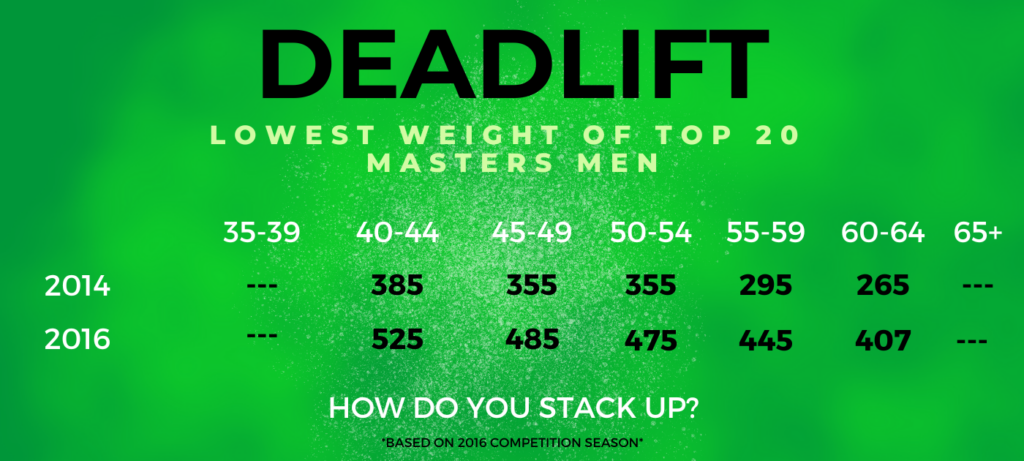
Men’s – Across the board, the jump in the lowest score from the two times this max has been tested – 2014 and 2016 – is drastic, increasing by over 100 pounds in every division. And, impressively, the lowest score for the 60+ division in 2016 beat the lowest score in the 40-44 division in 2014 by 22 pounds, proving that old man strength does indeed exist.
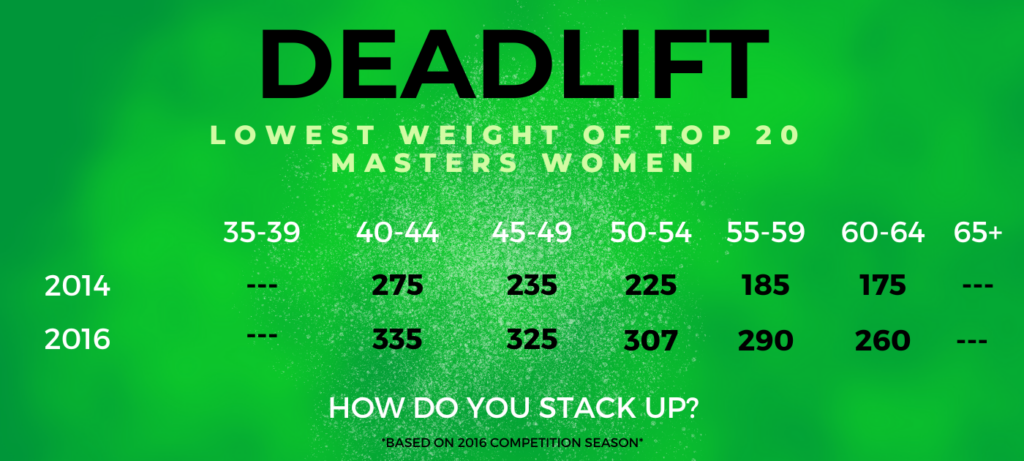
Women’s – We have seen significant increases in the deadlift numbers of the women’s age group divisions in the two years it was tested in competition. The lowest weight lifted by an athlete in the top 20 was above 300 pounds in three of the five divisions that tested and we suspect that the 55-59 year olds will break that plateau the next time this lift appears in competition.
How to Improve Your Deadlift
Accessory work! By training accessory lifts, an athlete is able to substantially improve strength by stressing their body in many different angles, causing different stimuli to a certain area that a classic barbell lift may not be able to challenge as well. Accessories allow an athlete to increase the volume of training while at the same time taking the stress off a specific joint. Along with allowing an increased workload they can be used to control volume, training density, and intensity.
Develop Your Deadlift Strength
Deadlift 6-Week Accessory Program
Back Strength 6-Week Accessory Program
Strength Program
Clean and Jerk
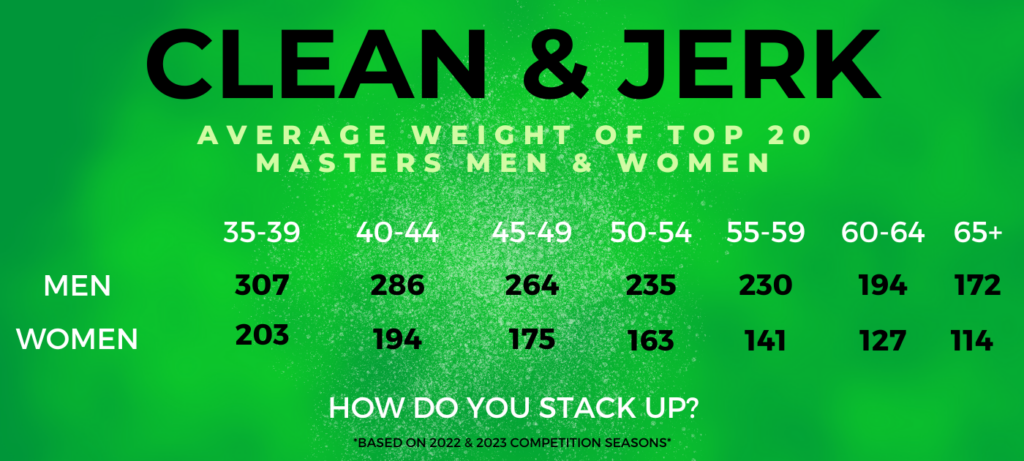
Men’s & Women’s – The most common limiting factors for Masters athletes here are jerk mobility, front rack mobility, and squat strength. The clean can be a limiter for some as they can’t stand it up once they catch it. If any of this sounds like you watch the video below for tips from Invictus Strength coach, Hunter Britt.
How to Improve Your Clean and Jerk
Focus on opening up the thoracic spine for jerks plus holding your overhead position which are both key for opening up the jerk position. Also, try widening your grip up a bit after the clean and before the jerk. That allows for more clearance when the bar is overhead and can help mobility. Clean grip sotts press are another great dynamic exercise to do to improve that position. For athletes who can’t stand up the clean, train Clean + Front Squat + Jerks normal clean and jerk days, plus, add an extra day of squat work to your routine (Front Squat or Back Squat). Ensuring that you’re receiving the bar smoothly is key also, in order to make sure you’re catching an optimal bounce out of the hole.
Develop Your Clean and Jerk Strength
Lower Body 6-Week Accessory Program
3-Day Weightlifting Program
Snatch
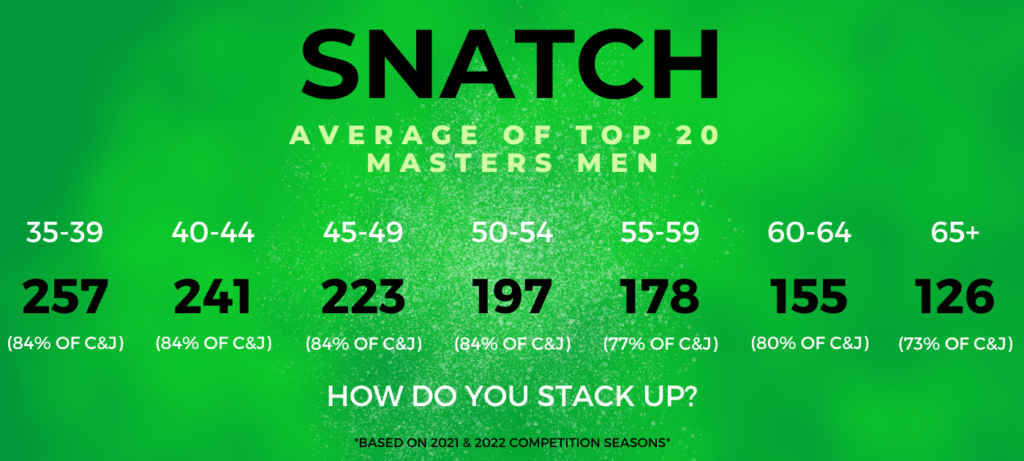
Men’s – Up until the 55-59 age group, the average snatch is well over the recommended benchmark of 80% (83-84% range) of the average clean and jerk. It’s with the 55-59 group that the average snatch percentage drops below that and we see 77% for this group and 73% for the 65+ group. Interestingly, the 60-64 group sits right at 80%.
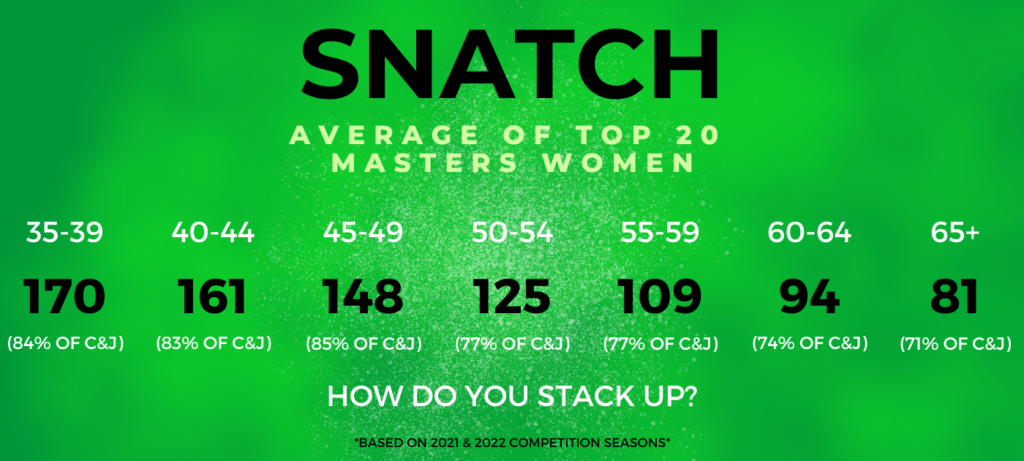
Women’s – We see the snatch percentage drop below the benchmark 80% of the clean and jerk in the 50-54 age group for women with a 77% rate for both the 50-54 and the 55-59 age groups, 74% for the 60-64 group, and 71% for the 65+ women. This indicates that there is still some room for snatches to increase by up to 10% in the older four divisions as athletes both continue to build strength and also age into those divisions with their heavier lifts. Expect to see these averages go up a few percentage points each time they are tested.
How to Improve Your Snatch
Mobility and technique work! However, if you are not looking to compete in the sport of CrossFit over the age of 50, a lot of times we don’t recommend you snatch if you don’t already have excellent mobility. There is just no need to risk injury and there are other ways – like the clean and jerk – to get the same desired stimulus. (just an example, please make this what you recommend)
Develop Your Snatch Strength
3-Day Weightlifting Program
Mind-Muscle Mobility Routines
Shoulder to Overhead
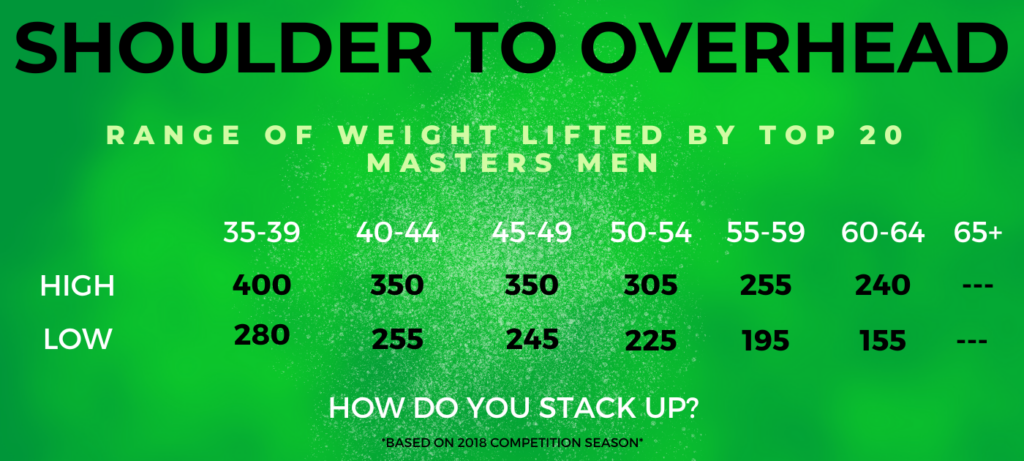
Men’s – The range in the amount of weight lifted from the #1 to the #20 athletes on the list is enormous which means there is room for you to place yourself amongst the best in the world.
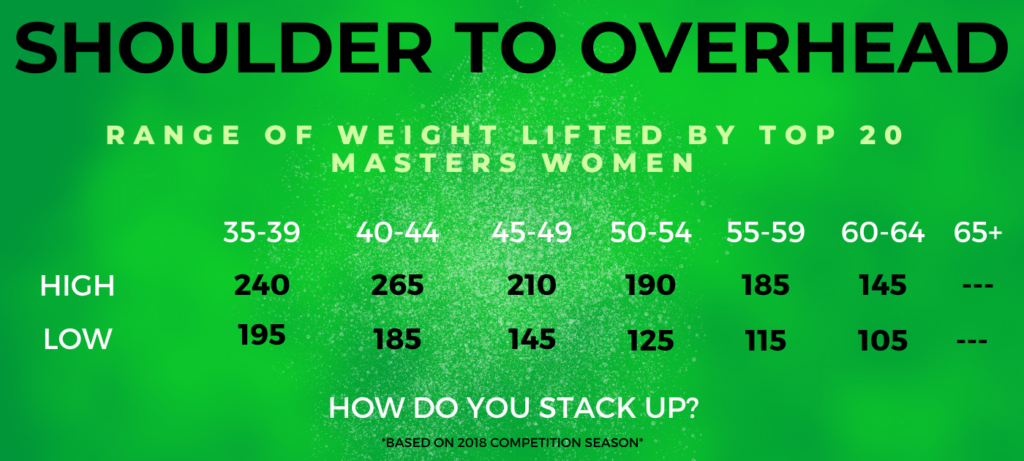
Women’s – Not as big as a gap between the high and low numbers for the women but still some room to wiggle your way in. To be competitive though, you’ll need to be pushing 200 pounds until you hit the 50-54 age group.
How to Improve Your Shoulder to Overhead
Develop upper body strength, shore up imbalances, and practice technique! As we know, nobody is going to strict press when shoulder to overhead gives you the option to jerk. This is where technique comes into play and can make or break your chances of pushing into the top numbers.
Develop Your Shoulder to Overhead Strength
3-Day Weightlifting Program
Strength Program
Upper Body 6-Week Accessory Program
Mind-Muscle Mobility Routines
Front Squat
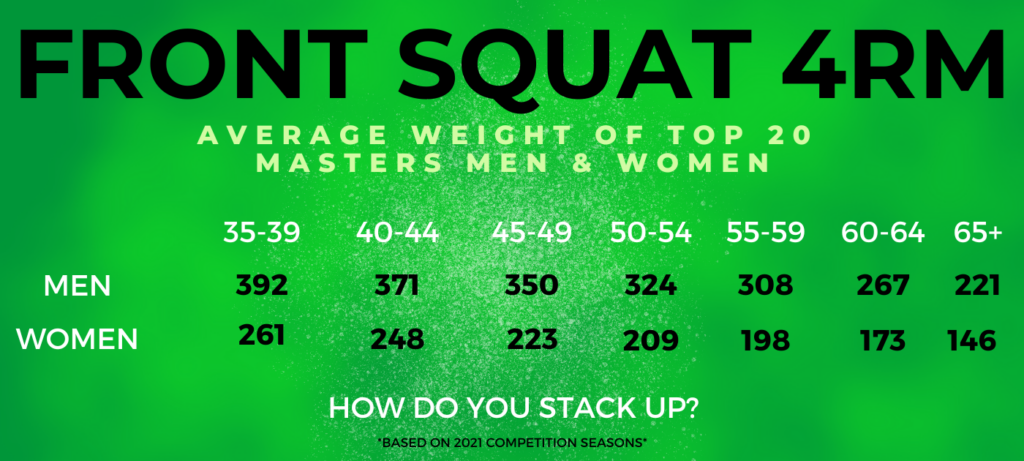
Men’s & Women’s – The fact that a 4RM was tested vs a 1RM helped reveal that the biggest weakness we see amongst competitors, especially in the upper divisions, is front rack mobility closely followed by upper back strength. We attribute the larger drop in weight at the oldest division to these things more than leg strength.
How to Improve Your Front Squat
Improve your front rack mobility and develop your leg and/or back strength! Many people will find that when tested, the ratio between their front squat and back squat are off; for a balanced athlete, that ratio should be around 85%. The front squat recruits more quadriceps and the back squat is a more posterior dominant movement; if your front squat is below 85% of your back squat then you probably need more front squats (and quads) in your life. If you’ve ever gotten bruises on your sternum or collarbones, then this could be a weakness in the upper back and something to focus on strengthening. For front rack mobility – try front squatting with a hookgrip for a few months and doing holds at the bottom of the squat with a full grip.
Develop Your Front Squat Strength
Strength Program
Lower Body 6-Week Accessory Program
Back Strength 6-Week Accessory Program
Overhead Squat
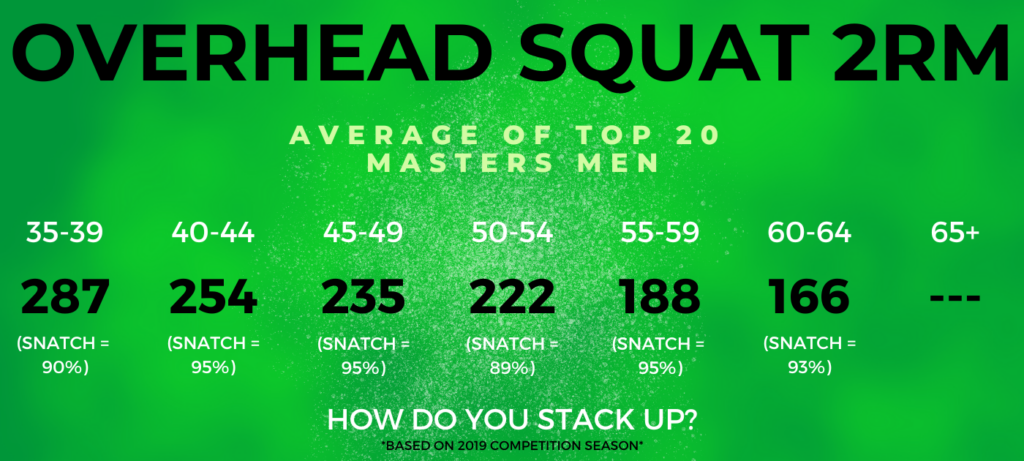
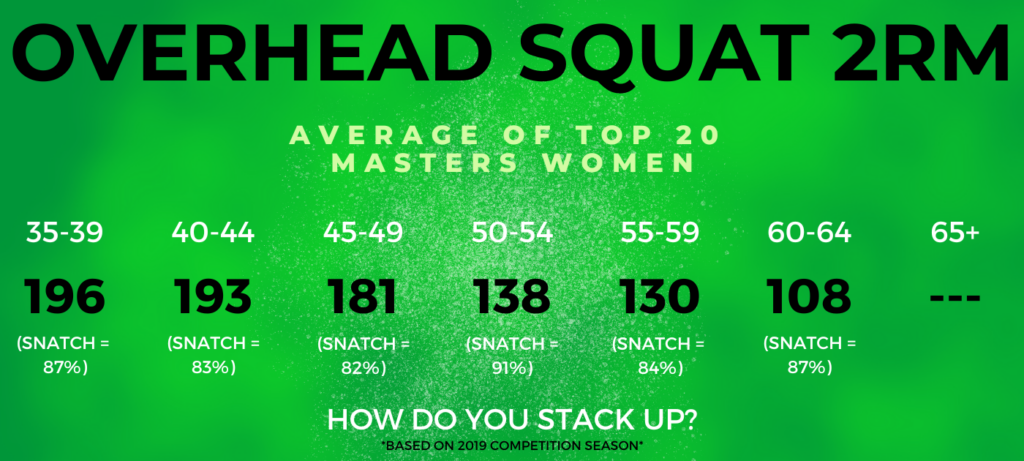
Men & Women – Some impressive averages for the 2-RM overhead squat. It is just as impressive how relatively consistent both men and womens 2-RM OHS are in relation to their 1-RM snatch. Men, across all divisions, are hitting a snatch at 90-95% of their 2-RM OHS. Women, across all divisions, are hitting a snatch at 82-91% of their 2-RM OHS. This is a great indicator of a well balanced competitive masters athlete when it comes to snatching. If their snatches were 65-70% of their overhead squat then we’d know that snatch technique is an issue but that isn’t the case. People are lifting relatively close to what their max overhead squat is, which is awesome to see. It would be great to see the women have a bit heavier of a snatch in relation to their overhead squat but this could just indicate a lack of exposure with the lifts, considering males have likely been lifting for a longer period of time in the masters divisions.
As you’ll see with the younger divisions, their 1-RM snatch hovers around 86-90% of their 2-RM Overhead Squat. The older age divisions are closer to snatching only 75% of their 2-RM overhead squat. We aren’t surprised with this as most younger athletes in this sport are typically snatching relatively higher numbers due to the speed and mobility demands of this lift. So it’s no wonder that the older age groups are able to knock out some heavy overhead squats but their snatch numbers tell us that their technique is a limiting factor. This should give older athletes encouragement knowing that they are strong enough to receive heavy weight in the bottom of their snatch; it’s just a matter of improving their snatch technique.
How to Improve Your Overhead Squat
Continue working on mobility, midline stability, and upper body strength.
Develop Your Overhead Squat Strength
Upper Body 6-Week Accessory Program
Abdominal 6-Week Accessory Program
Mind-Muscle Mobility Routines
How can you reach these masters strength numbers?
After reviewing the strength numbers and insights, do you see some room for improvement in your strength? If so, we have options for you! Strength takes time to build so if that is a major priority of yours then you may consider taking a full cycle to focus on developing strength via our Strength Program. Many have experienced huge strength gains following this program.
If you are looking to fine tune some of your strength numbers while continuing to focus on developing other skills then you may consider joining the Invictus Masters Program.
Also Check Out…
How to Estimate Your 1RM
The Right Stuff – Programming for the Masters Athlete
Master Your Potential as a CrossFit Masters Athlete
Invictus Masters Program
This program incorporates strength cycles while still working on gymnastics skills often tested in CrossFit while still focusing on metabolic conditioning to leave you primed and ready for whatever competitive goals you have in CrossFit.
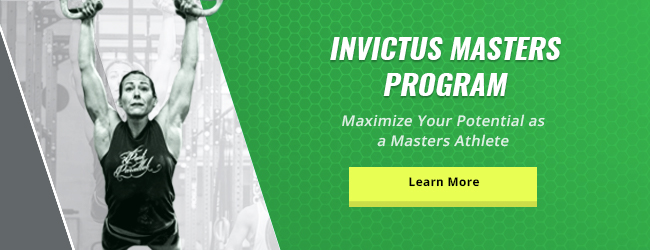
Your articles always make me think and reflect on my own life Thank you for prompting me to be introspective and make positive changes